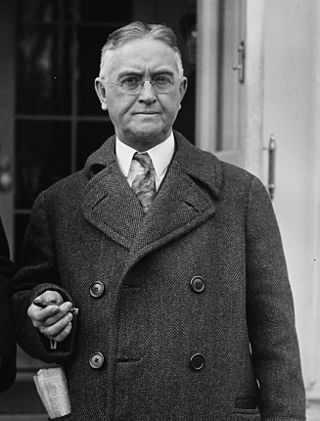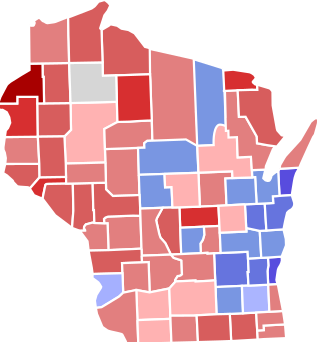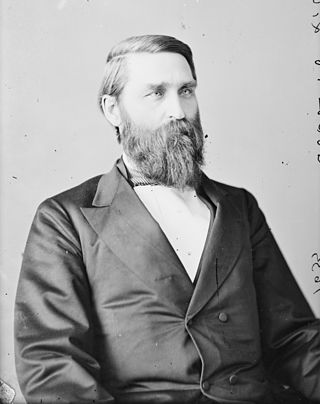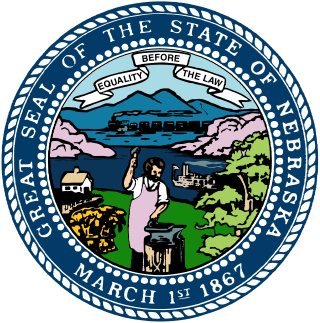
Presidential elections were held in the United States on November 4, 1884. Democratic Governor Grover Cleveland of New York narrowly defeated Republican James G. Blaine of Maine. It was set apart by mudslinging and personal allegations that eclipsed substantive issues, such as civil administration change. Cleveland was the first Democrat elected president of the United States since James Buchanan in 1856, the first to hold office since Andrew Johnson left the White House in 1869, and the last to hold office until Woodrow Wilson, who began his first term in 1913. For this reason, 1884 is a significant election in U.S. political history, marking an interruption in the era when Republicans largely controlled the presidency between Reconstruction and the Great Depression.

The Nebraska Democratic Party (NDP) is the affiliate of the Democratic Party in the state of Nebraska. Over 700 Democrats are elected across the state of Nebraska. Jane Kleeb is the chair of the Nebraska Democratic Party and also serves as the Midwest Chair of the Association of State Democratic Committees.

The 1885 New York state election was held on November 3, 1885, to elect the governor, the lieutenant governor, the secretary state, the state comptroller, the attorney general, the state treasurer and the state engineer, as well as all members of the New York State Assembly and the New York State Senate.

The 1924 Nebraska gubernatorial election was held on November 4, 1924, and featured former state Senator Adam McMullen, a Republican, defeating Democratic nominee, former state Representative John N. Norton, and Progressive nominee, Omaha City Commissioner Dan B. Butler.

The 1882 Colorado gubernatorial election was held on November 7, 1882. Democratic nominee James Benton Grant defeated Republican nominee E. L. Campbell with 51.07% of the vote. This election marks the first time that Colorado ever supported a Democratic Party candidate for governor. Grant flipped 11 counties previously won by Pitkin, most notably Arapahoe County, home at the time to the state capital of Denver. Conversely, Campbell only managed to flip two counties, namely the sparsely populated counties of Costilla and Huerfano in southern Colorado.

The April 1876 Connecticut gubernatorial election was held on April 3, 1876. Incumbent governor and Democratic nominee Charles R. Ingersoll defeated Republican nominee H. Robinson with 51.85% of the vote.

The 1881 Wisconsin gubernatorial election was held on November 8, 1881.

The 1884 Wisconsin gubernatorial election was held on November 4, 1884.

The 1879 Maine gubernatorial election was held on September 8, 1879. Republican nominee Daniel F. Davis defeated Greenback nominee Joseph L. Smith and incumbent Governor Alonzo Garcelon. This election saw the continued rise of the newly popular Greenback party, it was an American political party with an anti-monopoly ideology which was active between 1874 and 1889.

The 1894 Nebraska gubernatorial election was held on November 6, 1894. Incumbent Republican Governor Lorenzo Crounse did not stand for re-election. Populist and Democratic fusion nominee Silas A. Holcomb defeated the Republican nominee, incumbent Lieutenant Governor of Nebraska Thomas Jefferson Majors.

The 1892 Nebraska gubernatorial election was held on November 8, 1892. Incumbent Democratic Governor James E. Boyd did not seek re-election. Lorenzo Crounse, the Republican nominee, defeated both the Democratic nominee, J. Sterling Morton, and the Populist nominee, Charles Van Wyck.

The 1886 Nebraska gubernatorial election was held on November 2, 1886.

The 1884 Nebraska gubernatorial election was held on November 4, 1884, and featured incumbent Governor James W. Dawes, a Republican, defeating Democratic nominee J. Sterling Morton for a second time after the 1882 election.

The 1878 Nebraska gubernatorial election was held on November 5, 1878. Incumbent Republican governor Silas Garber did not seek reelection. This election featured Republican nominee Albinus Nance, the Speaker of the Nebraska House of Representatives, defeating Democratic nominee Colonel William H. Webster, a lawyer from Merrick County, Nebraska, and Greenback Party nominee Levi G. Todd, a former member of the Nebraska Territorial House of Representatives from Cass County, Nebraska.

The 1876 Nebraska gubernatorial election was held on November 7, 1876. It was the first election held under the newly adopted Nebraska Constitution of 1875. The election featured incumbent Governor Silas Garber, a Republican, defeating Democratic nominee Paren England, a lawyer from Lancaster County, Nebraska, and Greenback Party nominee Jonathan F. Gardner, former independent candidate for Governor of Nebraska in 1874.

The 1880 Nebraska lieutenant gubernatorial election was held on November 2, 1880, and featured incumbent Nebraska Lieutenant Governor Edmund C. Carns, a Republican, defeating Democratic nominee T. J. Hamilton as well as Greenback nominee Peter Lansing and former Democratic nominee Samuel H. Calhoun. Originally, the Democratic party had nominated Calhoun for lieutenant governor. However, on October 11, 1880, Calhoun withdrew his candidacy, and the Democratic state central committee appointed T. J. Hamilton to replace him.

The 1882 Nebraska lieutenant gubernatorial election was held on November 7, 1882, and featured Republican nominee Alfred W. Agee defeating Democratic nominee Jesse F. Warner as well as Greenback nominee D. P. Reynolds.

The 1884 Nebraska lieutenant gubernatorial election was held on November 4, 1884, and featured Republican nominee Hibbard H. Shedd defeating fusion Democratic and Greenback (Anti-Monopoly) nominee Lewis C. Pace. Incumbent Nebraska Lieutenant Governor Alfred W. Agee was renominated at the Nebraska Republican state convention, but he was defeated for the nomination by Shedd by a vote of 292 to 153 of the delegates.

The 1886 Nebraska lieutenant gubernatorial election was held on November 2, 1886, and featured incumbent Nebraska Lieutenant Governor Hibbard H. Shedd, a Republican, defeating Democratic nominee Charles J. Bowlby as well as Prohibition Party nominee E. B. Graham and National Union Party nominee M. K. Lewis.

The 1896 Nebraska lieutenant gubernatorial election was held on November 3, 1896, and featured Populist and Democratic fusion nominee James E. Harris defeating his major rival, Republican nominee Orlando Tefft. Other candidates who received two percent of the vote or less included Gold Democratic nominee Owen F. Biglin, Prohibition nominee Lucius O. Jones, Socialist Labor nominee Fred Herman, and National Silver nominee Oscar Kent. Incumbent Nebraska Lieutenant Governor Robert E. Moore did not seek reelection.



















